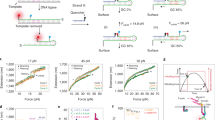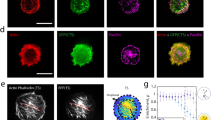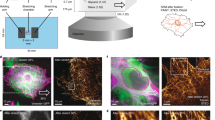Abstract
Förster resonance energy transfer (FRET)-based tension sensor modules (TSMs) are available for investigating how distinct proteins bear mechanical forces in cells. Yet, forces in the single piconewton (pN) regime remain difficult to resolve, and tools for multiplexed tension sensing are lacking. Here, we report the generation and calibration of a genetically encoded, FRET-based biosensor called FL-TSM, which is characterized by a near-digital force response and increased sensitivity at 3–5 pN. In addition, we present a method allowing the simultaneous evaluation of coexpressed tension sensor constructs using two-color fluorescence lifetime microscopy. Finally, we introduce a procedure to calculate the fraction of mechanically engaged molecules within cells. Application of these techniques to new talin biosensors reveals an intramolecular tension gradient across talin-1 that is established upon integrin-mediated cell adhesion. The tension gradient is actomyosin- and vinculin-dependent and sensitive to the rigidity of the extracellular environment.
This is a preview of subscription content, access via your institution
Access options
Access Nature and 54 other Nature Portfolio journals
Get Nature+, our best-value online-access subscription
$29.99 / 30 days
cancel any time
Subscribe to this journal
Receive 12 print issues and online access
$259.00 per year
only $21.58 per issue
Buy this article
- Purchase on Springer Link
- Instant access to full article PDF
Prices may be subject to local taxes which are calculated during checkout






Similar content being viewed by others
References
Petridou, N.I., Spiró, Z. & Heisenberg, C.P. Multiscale force sensing in development. Nat. Cell Biol. 19, 581–588 (2017).
Vogel, V. & Sheetz, M. Local force and geometry sensing regulate cell functions. Nat. Rev. Mol. Cell Biol. 7, 265–275 (2006).
Gordon, W.R. et al. Mechanical allostery: evidence for a force requirement in the proteolytic activation of notch. Dev. Cell 33, 729–736 (2015).
Rognoni, L., Stigler, J., Pelz, B., Ylänne, J. & Rief, M. Dynamic force sensing of filamin revealed in single-molecule experiments. Proc. Natl. Acad. Sci. USA 109, 19679–19684 (2012).
del Rio, A. et al. Stretching single talin rod molecules activates vinculin binding. Science 323, 638–641 (2009).
Buckley, C.D. et al. Cell adhesion. The minimal cadherin-catenin complex binds to actin filaments under force. Science 346, 1254211 (2014).
Finer, J.T., Simmons, R.M. & Spudich, J.A. Single myosin molecule mechanics: piconewton forces and nanometre steps. Nature 368, 113–119 (1994).
Grashoff, C. et al. Measuring mechanical tension across vinculin reveals regulation of focal adhesion dynamics. Nature 466, 263–266 (2010).
Austen, K. et al. Extracellular rigidity sensing by talin isoform-specific mechanical linkages. Nat. Cell Biol. 17, 1597–1606 (2015).
Wang, X. & Ha, T. Defining single molecular forces required to activate integrin and notch signaling. Science 340, 991–994 (2013).
Zhang, Y., Ge, C., Zhu, C. & Salaita, K. DNA-based digital tension probes reveal integrin forces during early cell adhesion. Nat. Commun. 5, 5167 (2014).
Morimatsu, M., Mekhdjian, A.H., Chang, A.C., Tan, S.J. & Dunn, A.R. Visualizing the interior architecture of focal adhesions with high-resolution traction maps. Nano Lett. 15, 2220–2228 (2015).
Freikamp, A., Cost, A.L. & Grashoff, C. The piconewton force awakens: quantifying mechanics in cells. Trends Cell Biol. 26, 838–847 (2016).
Borghi, N. et al. E-cadherin is under constitutive actomyosin-generated tension that is increased at cell–cell contacts upon externally applied stretch. Proc. Natl. Acad. Sci. USA 109, 12568–12573 (2012).
Chang, C.W. & Kumar, S. Vinculin tension distributions of individual stress fibers within cell–matrix adhesions. J. Cell Sci. 126, 3021–3030 (2013).
Krieg, M., Dunn, A.R. & Goodman, M.B. Mechanical control of the sense of touch by β-spectrin. Nat. Cell Biol. 16, 224–233 (2014).
Paszek, M.J. et al. The cancer glycocalyx mechanically primes integrin-mediated growth and survival. Nature 511, 319–325 (2014).
Hernández-Varas, P., Berge, U., Lock, J.G. & Strömblad, S. A plastic relationship between vinculin-mediated tension and adhesion complex area defines adhesion size and lifetime. Nat. Commun. 6, 7524 (2015).
Sun, Z., Guo, S.S. & Fässler, R. Integrin-mediated mechanotransduction. J. Cell Biol. 215, 445–456 (2016).
Fang, J. et al. Forced protein unfolding leads to highly elastic and tough protein hydrogels. Nat. Commun. 4, 2974 (2013).
Dietz, H. & Rief, M. Exploring the energy landscape of GFP by single-molecule mechanical experiments. Proc. Natl. Acad. Sci. USA 101, 16192–16197 (2004).
Critchley, D.R. Biochemical and structural properties of the integrin-associated cytoskeletal protein talin. Annu. Rev. Biophys. 38, 235–254 (2009).
Calderwood, D.A., Campbell, I.D. & Critchley, D.R. Talins and kindlins: partners in integrin-mediated adhesion. Nat. Rev. Mol. Cell Biol. 14, 503–517 (2013).
Mehlich, A., Austen, K., Ringer, P., Rief, M. & Grashoff, C. Evaluation of molecular tension sensors using single-molecule force spectroscopy and live cell FRET imaging. Protocol Exchange http://dx.doi.org/10.1038/protex.2015.095 (2015).
Geiger, B., Spatz, J.P. & Bershadsky, A.D. Environmental sensing through focal adhesions. Nat. Rev. Mol. Cell Biol. 10, 21–33 (2009).
Atherton, P. et al. Vinculin controls talin engagement with the actomyosin machinery. Nat. Commun. 6, 10038 (2015).
Demeautis, C. et al. Multiplexing PKA and ERK1&2 kinases FRET biosensors in living cells using single excitation wavelength dual colour FLIM. Sci. Rep. 7, 41026 (2017).
Murakoshi, H., Shibata, A.C.E., Nakahata, Y. & Nabekura, J. A dark green fluorescent protein as an acceptor for measurement of Förster resonance energy transfer. Sci. Rep. 5, 15334 (2015).
Shcherbakova, D.M., Hink, M.A., Joosen, L., Gadella, T.W.J. & Verkhusha, V.V. An orange fluorescent protein with a large Stokes shift for single-excitation multicolor FCCS and FRET imaging. J. Am. Chem. Soc. 134, 7913–7923 (2012).
Yao, M. et al. The mechanical response of talin. Nat. Commun. 7, 11966 (2016).
Haining, A.W.M., von Essen, M., Attwood, S.J., Hytönen, V.P. & Del Río Hernández, A. All subdomains of the talin rod are mechanically vulnerable and may contribute to cellular mechanosensing. ACS Nano 10, 6648–6658 (2016).
Chan, C.E. & Odde, D.J. Traction dynamics of filopodia on compliant substrates. Science 322, 1687–1691 (2008).
Elosegui-Artola, A. et al. Mechanical regulation of a molecular clutch defines force transmission and transduction in response to matrix rigidity. Nat. Cell Biol. 18, 540–548 (2016).
Besser, A. & Safran, S.A. Force-induced adsorption and anisotropic growth of focal adhesions. Biophys. J. 90, 3469–3484 (2006).
Bouchet, B.P. et al. Talin-KANK1 interaction controls the recruitment of cortical microtubule stabilizing complexes to focal adhesions. eLife 5, e18124 (2016).
Sun, Z. et al. Kank2 activates talin, reduces force transduction across integrins and induces central adhesion formation. Nat. Cell Biol. 18, 941–953 (2016).
Austen, K., Kluger, C., Freikamp, A., Chrostek-Grashoff, A. & Grashoff, C. Generation and analysis of biosensors to measure mechanical forces within cells. Methods Mol. Biol. 1066, 169–184 (2013).
von Hansen, Y., Mehlich, A., Pelz, B., Rief, M. & Netz, R.R. Auto- and cross-power spectral analysis of dual trap optical tweezer experiments using Bayesian inference. Rev. Sci. Instrum. 83, 095116 (2012).
Tolic´-Nørrelykke, S.F. et al. Calibration of optical tweezers with positional detection in the back focal plane. Rev. Sci. Instrum. 77, 103101 (2006).
Moffitt, J.R., Chemla, Y.R., Izhaky, D. & Bustamante, C. Differential detection of dual traps improves the spatial resolution of optical tweezers. Proc. Natl. Acad. Sci. USA 103, 9006–9011 (2006).
Wang, M.D., Yin, H., Landick, R., Gelles, J. & Block, S.M. Stretching DNA with optical tweezers. Biophys. J. 72, 1335–1346 (1997).
Stigler, J., Ziegler, F., Gieseke, A., Gebhardt, J.C. & Rief, M. The complex folding network of single calmodulin molecules. Science 334, 512–516 (2011).
Würflinger, T., Gamper, I., Aach, T. & Sechi, A.S. Automated segmentation and tracking for large-scale analysis of focal adhesion dynamics. J. Microsc. 241, 37–53 (2011).
Sprague, B.L. & McNally, J.G. FRAP analysis of binding: proper and fitting. Trends Cell Biol. 15, 84–91 (2005).
Verveer, P.J., Squire, A. & Bastiaens, P.I. Global analysis of fluorescence lifetime imaging microscopy data. Biophys. J. 78, 2127–2137 (2000).
James, F. Statistical Methods in Experimental Physics 2nd edn. (World Scientific Publishing Co., 2006).
Acknowledgements
The authors thank R. Fässler (MPI of Biochemistry, Department of Molecular Medicine) for providing talin-deficient cells, C. Schweizer for help with programming, the MPIB core facility for technical support, and the Microscopy Rennes Imaging Centre (MRic), where multiplex FRET experiments were performed. C.G. is supported by the German Research Council (DFG, GR3399/5-1 and GR3399/6–1), the Collaborative Research Centre SFB863 (B9), and the Max Planck Förderstiftung. M.R. acknowledges support from the German Research Council through the Collaborative Research Centre SFB863 (A2), and M.T. acknowledges funding by the Ligue Régionale Contre le Cancer. A.F. was supported by the Boehringer Ingelheim Fonds.
Author information
Authors and Affiliations
Contributions
P.R. generated expression constructs and cell lines, performed experiments, wrote data analysis software, and analyzed data. A.W. performed calibration experiments, data analysis, and theoretical modeling with A.M. under the supervision of M.R. A.-L.C. wrote FLIM analysis software and advanced data analysis algorithms with assistance from B.S. A.F. generated tools and performed initial experiments. M.T. provided multiplexing fluorophores and supervised dual-colour FLIM experiments and data analysis. C.G. purified TSMs, coordinated experiments, and wrote the manuscript with input from all authors.
Corresponding author
Ethics declarations
Competing interests
The authors declare no competing financial interests.
Integrated supplementary information
Supplementary Figure 1 Single-molecule calibration of F40-TSM.
(a) Representative stretch-relax cycle of F40-TSM. As expected, distinct unfolding events were not detected at low pN forces owing to the spring-like properties of the F40 peptide. Increasing forces to about 40–55 pN resulted in the expected fluorophore unfolding. (b) Discernible unfolding events were not observed at low pN forces during F40-TSM extension. Note that these results are consistent with previously published data that were acquired with a different instrumental setup and calibration construct. The solid black line indicates an extensible WLC-fit to the stretch trace; the dashed black line was derived from the average extensible WLC-fit characterizing FL-TSM in the folded state (and therefore indicates the extension of the DNA-linker only). (c) Contour length histograms of the F40-TSM-DNA construct (gray). Data in green were extracted from FL-TSM experiments and correspond to the extension of the DNA linkers only. The difference between both data sets corresponds to the length increase of the F40 peptide (ΔLCF40=10.6±5.9 nm) as shown in Fig. 1h (n=41 unfolding events from three F40-TSM molecules).
Supplementary Figure 2 Modelling the FRET-force correlation.
(a) Exemplary force-extension graph of a given sensor peptide. The extension of the folded state (indicated in blue) stays constant with force; the extension of unfolded peptide (red) increases with force, according to the WLC model (red). The black curve shows the mean extension of the sensor peptide <XP(Fi)> at a given force Fi, which is determined by the sum of the extensions corresponding to the folded/unfolded state and weighted with the probability of being in the respective conformation. (b) Force-probability correlation depicting the probability of a given sensor peptide to be in the unfolded (red) or folded (blue) state at force Fi. (c) FRET efficiency plot indicating the maximum FRET efficiency, which is obtained in the folded state. The black line depicts the 1/R6 relation of FRET-efficiency with the donor-acceptor separation distance. The red marker indicates the expected FRET efficiency in the unfolded (stretched) state, and the black marker indicates the effective FRET efficiency at the mean extension <XP(Fi)>. (d) Sampling through the entire force range yields the FRET-force relation (see (eq.13) and Fig. 1f).
Supplementary Figure 3 Tension sensor modules (TSMs) and talin expression constructs.
(a) Three TSMs were employed in the study: FL-TSM sensitive to 3–5 pN, HP-TSM sensitive to 6–8 pN, and F40-TSM that responds to 1–6 pN. (b-d) The respective tension sensor modules were incorporated into talin-1 at position aa 447 (called talin-TSM-447) and aa 1973 (talin-TSM-1973). As a zero-force control, the TSMs were C-terminally attached to talin. (e-g) To investigate potential effects on fluorophore properties and to determine intermolecular FRET, individual fluorophores were C-terminally attached (e), inserted at aa 447 (f) and aa 1973 (g); to determine intermolecular FRET, YPet- and mCherry-tagged constructs were co-expressed in cells. (h) In the talin-FL-1973 (ΔABS3) construct, talin was truncated at aa 2300.
Supplementary Figure 4 Normal subcellular localization of talin biosensors and controls.
(a-d) Immunostainings of Tln1−/−Tln2−/− cells stably re-expressing talin-YPet (a), talin-FL-Con (b), talin-FL-447 (c) and talin-FL-1973 (d); same cells as shown in Fig. 2b. FAs were marked by vinculin staining; f-actin was visualized by phalloidin labelling. Scale bars: 20 μm.
Supplementary Figure 5 Schematic illustration of the data analysis workflow to isolate the FA signal and determine FA-FRET efficiencies.
(a) Raw images are used to define a region of interest (ROI) allowing the isolation of the cellular signal and exclusion of background noise. (b) A FA mask is generated to remove cytoplasmic signal and extract data from FAs. (c) Fluorescence lifetimes of the donor fluorophore are isolated from the FA signal; this information is used to generate a histogram of photon arrival times, which is fitted by a mono-exponential decay function. Thus, the resulting lifetime value (displayed as one blue dot in our box plots) represents the average lifetime of all isolated FAs from an individual cell.
Supplementary Figure 6 Fluorescence lifetimes of talin biosensors are independent of the donor intensity.
(a-c) No correlation of experimentally determined fluorescence lifetimes and donor intensity in cells expressing talin-TSM-447 and talin-TSM-1973 as indicated by the Pearson correlation coefficient (PCC). HP-based sensor expressing cells were analysed in (a) (PPC: talin-HP-447=-0.33 and talin-HP-1973=0.17), FL-based sensors in (b) (PCC: talin-FL-447=-0.48 and talin-FL-1973=0.01), and F40-based sensors in (c) (PCC: talin-F40-447=‑0.19 and talin-F40-1973=-0.22).
Supplementary Figure 7 Effects of Y-27632 treatment on FA morphology and talin tension.
(a) Representative intensity images of talin-FL-447 and talin-FL-1973 expressing cells before and after Y-27632 treatment. As expected, FA size and intensity are reduced in response to ROCK-inhibition. Scale bar indicates 20 μm. (b-d) Individual FRET ratio traces of cells expressing talin-FL-447 (b), talin-FL-1973 (c) and talin-FL-Con (d) after Y-27632 treatment.
Supplementary Figure 8 Micro-patterned substrates to control cell morphology, FA size and myosin activity.
(a-d) Representative images of talin-FL-1973 expressing cells seeded on triangular (a, c) or disc-shaped micro-patterned substrates (b, d). Cells were immunostained with paxillin (magenta) or phosphorylated myosin light chain (p-MLC; magenta), and labelled with phalloidin to visualize the f-actin network (gray). The talin signal is shown in green. Scale bars indicate 20 μm. (e, f) Analyses of FA size (e) and eccentricity (f) confirm distinct FA morphologies on triangular substrates as compared to disc-shaped micro-patterns (n=12, 12 cells, pooled from two experimental days; KS test: ***: p<0.001).
Supplementary Figure 9 Talin tension in cells on micro-patterned substrates.
(a) Representative ratiometric FRET images of cells expressing talin-FL-447. Note that the FRET ratio is virtually unaffected by the cell shape and FA morphology. (b) Corresponding ratiometric FRET images of cells expressing talin-FL-1973. Tension at aa 1973 is decreased in cells on disc-shaped substrates. Scale bars indicate 20 μm.
Supplementary Figure 10 Effects of ABS3-deletion in talin on the morphology of cells.
(a, b) Representative images of Tln1−/−Tln2−/− cells re-expressing talin-FL-1973 (a) or talin-FL-1973 (ΔABS3) (b). Cells were stained with paxillin (magenta) to mark FAs, and they were labelled with phalloidin (gray) to visualize f-actin; talin signal is shown in green. Scale bars indicate 20 μm.
Supplementary Figure 11 Evaluation of talin tension at aa 1973 in cells on soft substrates.
Tln1−/−Tln2−/− cells expressing talin-FL-1973 were analysed on substrates with distinct rigidities (25 kPa, 12 kPa, 4 kPa and 1 kPa). In contrast to talin-HP-447 experiments (see Fig. 4j), FRET values remained rather constant (n=23, 21, 17, 29, 20 cells, pooled from three independent experiments; KS test: ***: p<0.001; *: p<0.05; not significant (n.s.): p>0.05).
Supplementary Figure 12 Tension sensor multiplexing (MPX) control experiments.
(a) Fluorescence lifetime evaluation of individual fluorophores and MPX-TSMs expressed in the cytoplasm of cells (n=25, 26, 14, 31, 31, 39 cells, pooled from three independent experiments). (b) Cells expressing the respective MPX donor fluorophore (LmO-only or TFP-only) were analyzed in the presence or absence of the orthogonal donor fluorophore. FRET efficiencies are unaffected by the presence or absence of the orthogonal donor fluorophore (n=21, 24, 31, 24 cells, pooled from six independent experiments). (a, b: KS test, ***: p<0.001; not significant (n.s.): p>0.05).
Supplementary Figure 13 Minimal photon count required for the calculation of molecular engagement ratios.
The photon count required for a given measurement precision (here: σ*=0.2) depends exponentially on the lifetime ratio. In our data sets, this ratio is about 0.75 (indicated by the dashed grey line). Note that the number of required photons is also sensitive to the background photons, which should be determined independently.
Supplementary information
Supplementary Text and Figures
Supplementary Figures 1–13
Supplementary Table 1
Raw data and statistical information
Rights and permissions
About this article
Cite this article
Ringer, P., Weißl, A., Cost, AL. et al. Multiplexing molecular tension sensors reveals piconewton force gradient across talin-1. Nat Methods 14, 1090–1096 (2017). https://doi.org/10.1038/nmeth.4431
Received:
Accepted:
Published:
Issue Date:
DOI: https://doi.org/10.1038/nmeth.4431
This article is cited by
-
Curved adhesions mediate cell attachment to soft matrix fibres in three dimensions
Nature Cell Biology (2023)
-
Light-driven biological actuators to probe the rheology of 3D microtissues
Nature Communications (2023)
-
Organization, dynamics and mechanoregulation of integrin-mediated cell–ECM adhesions
Nature Reviews Molecular Cell Biology (2023)
-
Tension-tuned receptors for synthetic mechanotransduction and intercellular force detection
Nature Biotechnology (2023)
-
The carbohydrate-binding module mediates mCherry protein anchoring on the cell wall in rice
Plant Cell, Tissue and Organ Culture (PCTOC) (2023)



